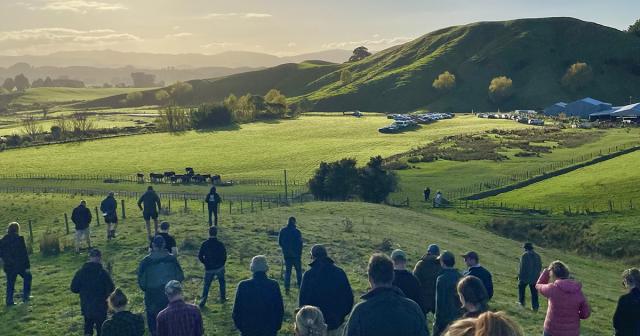Technologies such as virtual fences, drones and parasite-controlling fertiliser have the potential to be game-changers for sheep and beef farmers and were the focus of a recent Beef + Lamb New Zealand field day.

The B+LNZ Wairarapa Farming for Profit field day shone a spotlight on these three technologies, highlighting their potential to improve on-farm efficiency and lower production costs, all important factors in building robust farming businesses.
Virtual fencing
Host farmers, Ian, Janet and Callum Woodhouse have been using Halter collars on their beef cows for over a year (Callum used to work for Halter before returning to the farm). While they haven’t yet got enough data to fully calibrate their return on investment, they have had significant success with feed allocation, pasture quality and growing and utilising more feed.
Feed allocation
The family used the collars to contain calving cows within an area of the paddock while the rest of the area was used for lambing ewes.
These calving areas had been spelled through summer and autumn to allow feed to be saved.
Holding the cows within a set area protected sensitive (wet) areas of the paddock and allowed the lambing ewes to have a greater allocation of feed by removing competition from cows.
After lambing, and when ground conditions allowed, the virtual fences were removed, and cows and calves spread amongst the ewes and lambs. The family found this strategy benefited both lamb survival and weaning weights.
Pasture quality
Collars allowed the family to use cows to groom pastures soon after the bull went out. This was a lot earlier than was normal.
By forcing cows to eat the stem and dead matter in the pasture, the regrowth was of much better quality. This high-quality feed (with a potentially lower parasite burden) allowed for more fast-growing stock to be carried on their hill country.
The challenge for the family was to control feed on other areas of the farm and they are considering adjusting their stocking rates.
Growing and utilising more feed
By using the collars to accurately allocate feed and drive feed utilisation through summer and autumn, the Woodhouse family has found the total amount of feed they have available has increased substantially.
The combination of collars and intensive grazing has allowed the family to back fence and avoid overgrazing fresh regrowth.
To better utilise this fresh feed, the family is looking to increase the trade cattle component of their business while continuing to use cows to groom pastures through summer and autumn.
Other benefits
Other benefits of the collars and virtual fences include allowing calves to creep graze (freely graze the high-quality components of the pasture while the cows are held back by the virtual fence), being able to protect sensitive or hazardous areas of the farm, minimising nutrient transfer through more concentrated grazing, protecting fragile farm infrastructure and creating more of a barrier between stock classes.
Drones
Speaking at the field day, Mitch Kelly from Kelly Commercial Drone Solutions outlined the benefits of drones and the services his company offers.
While the full potential of drones in agriculture has yet to be realised, this technology is helping integrate precision and efficiency into farming systems.
Applications include spraying targeted areas with liquid fertiliser and/or herbicides, spreading seed and granular fertiliser onto mapped areas and multispectral and thermal imaging to assess plant health, pests and identify variation across a paddock.
How they work
Typically, a smaller drone is used to map an area collecting high-resolution, multispectral imaging data. These maps are used to define the flight paths of larger drones which are used to carry out the designated task. These larger drones have a 50L tank capacity which covers around 1ha per load.
AI-guided routes enable variable-rate application of inputs across the paddock and droplet size can be adjusted during flight.
Radar technology allows drones to be flown at night which is beneficial for nitrogen applications as there is reduced risk of leaf burn.
Costs
On flat land, spraying costs $50/ha while on hill country, the cost is $60-$70/hour depending on time and complexity.
Gorse control costs around $450/hour and seed spreading is around $75/ha. While these costs are comparable with traditional boom spraying, the drone offers increased flexibility and precision.
Reducing parasites on pasture
Ballance Agri-Nutrients, in collaboration with AgResearch and MPI through the Sustainable Farming Fund, is trialling an innovative fertiliser-based product aimed at reducing parasite larvae on pasture. It is intended that this product be used in conjunction with drenching and other on-farm management strategies.
The product, which is a liquid formulation, has a dual benefit. It provides nitrogen to help drive pasture growth while targeting L3 parasite larvae on the pasture sward.
The aim is to time the application of this product so that through direct contact, it kills the L3 larvae as it moves up the pasture sward.
Laboratory trials have shown 90% efficacy in reducing parasite larvae and on-farm trials have also showed good control based on faecal egg counts.
Once approved for use by Agricultural Compounds and Veterinary Medicines, the product will likely be subject to more practical on-farm trials on timing and seasonality, pasture covers and feed types and how it can be used with other parasite management strategies.